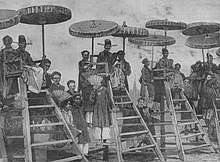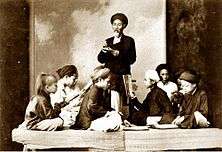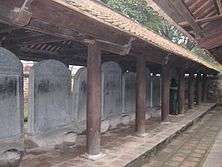Confucian court examination system in Vietnam
The Confucian court examination system in Vietnam (Chinese: 越南科舉制度, Vietnamese : Chế-độ khoa-cử Việt-nam ; 1075 – 1913) was a system for entry into the civil service modelled on the Imperial examination in China, based on knowledge of the classics and literary style.
Salles_Andr%C3%A9_btv1b53198692x_1.jpg)

History

The exams entered Vietnam during the long era of Chinese occupation and adopted by subsequent independent dynasties as a way of filling the civil service. They were instituted at court level by the Lý Dynasty's Emperor Lý Nhân Tông in 1075 and continued some 1000 years later toward the final years of the Nguyễn Dynasty's Emperor Khải Định. The examinations were suspended by the French in 1913 with the very last local exams occurring from 1915 to 1919, thus making Vietnam the last country to hold Confucian civil service examinations. The royal court exams were typically held every three years, though the award of first prizes was far less frequent.
Exam procedures

The examination system was divided into a regional and a national examination held at the royal capital.[1] Provincial examinations led only to the degree of tú tài (秀才 junior bachelor) and cử nhân (舉人 senior bachelor). From 1829 a provincial mandarin could progress to phó bảng, the lowest level of national exam, under the scholars with the rank of tiến sĩ.
The examinations themselves were composed of three or four tests, followed by a phúc hạch or control examination to confirm identity.[2]
Aside from accrediting rank and file scholars to the court and mandarin civil service positions gleaned from the successful regional candidates, the exams also appointed lead scholars for the court exam (Thi Đình) in the capital, the title of trạng nguyên. This title was first awarded to Lê Văn Thịnh (d.1096). Subsequent exams starting in 1247 and onward were divided into three first class grades along the Chinese model with trạng nguyên as the first of three prizes. The first trạng nguyên under this system was Nguyễn Hiền. The full list of trạng nguyên therefore includes 55 scholars if beginning from Lê Văn Thịnh, but only 49 if commencing from Nguyễn Hiền (awarded 1247, in the reign of Trần Thái Tông).
The three titles were as follows :
- Trạng nguyên (狀元) – first place, reserved for the best scholar
- Bảng nhãn (榜眼) – second place
- Thám hoa (探花) – third place
- Tiến sĩ (進士) – all the other successful applicants
The list of trạng nguyên includes several notable figures in Vietnam's history, such as Mạc Đĩnh Chi (awarded 1304, in the reign of Trần Anh Tông) and Nguyễn Bỉnh Khiêm (awarded 1535, in the reign of Mạc Thái Tông). The last trạng nguyên was awarded to Trịnh Tuệ in 1736 during the reign of Lê Ý Tông.[3][4][5]
References
- John Kleinen Facing the Future, Reviving the Past: A Study of Social Change in ... – 1999 – Page 71 "The classical examination system was divided into a regional and a general examination (the last one was organized at the royal capital). The first led to the degree of tu tai (junior bachelor) and cu nhan (senior bachelor), the second to pho bang (junior doctor) and tien si (senior doctor). After the abolition of the examination system in 1913, the French introduced a new system, but ..."
- Truong Buu Lâm, New lamps for old: the transformation of the Vietnamese ... -Institute of Southeast Asian Studies – 1982 Page 11- "The provincial examinations consisted of three to four parts which tested the following areas: knowledge of the Confucian texts... The title of cu nhan or "person presented" (for office) was conferred on those who succeeded in all four tests."
- D. W. Sloper, Thạc Cán Lê Higher Education in Vietnam: Change and Response – 1995 Page 45 " For those successful in the court competitive examination four titles were awarded: trang nguyen, being the first- rank doctorate and first laureate, bang nhan, being a first-rank doctorate and second laureate; tham hoa, being a first-rank ..."
- Nguyẽ̂n Khá̆c Kham , Yunesuko Higashi An introduction to Vietnamese culture Ajia Bunka Kenkyū Sentā (Tokyo, Japan) 1967 – Page 20 "The classification became more elaborate in 1247 with the Tam-khoi which divided the first category into three separate classes: Trang-nguyen (first prize winner in the competitive examination at the king's court), Bang-nhan (second prize ..."
- Walter H. Slote, George A. De Vos Confucianism & the Family 998 – Page 97 "1428–33) and his collaborators, especially Nguyen Trai (1380–1442) — who was himself a Confucianist — accepted ... of Trang Nguyen (Zhuang Yuan, or first laureate of the national examination with the highest recognition in every copy)."